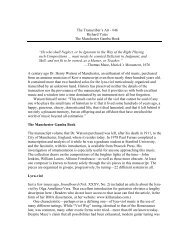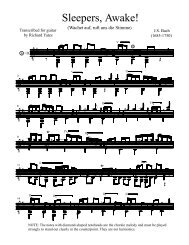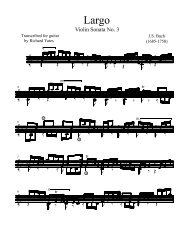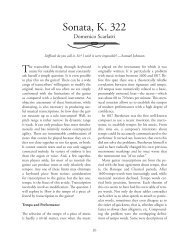Matthaeus Waissel's Lute Tutorial - Sarge Gerbode's Lute Page
Matthaeus Waissel's Lute Tutorial - Sarge Gerbode's Lute Page
Matthaeus Waissel's Lute Tutorial - Sarge Gerbode's Lute Page
You also want an ePaper? Increase the reach of your titles
YUMPU automatically turns print PDFs into web optimized ePapers that Google loves.
In the first example, place the forefinger over the f; stop the o with the middle finger, the z with the<br />
little finger, and the r with the ring finger. In the second example, place the forefinger over the o and<br />
D, stop the k with the little finger, the y with the middle finger, and hold the o. y, and D.<br />
So much for left hand fingering.<br />
When, however, the chords and coloraturas go further up past the frets onto the belly (where you<br />
must occasionally stop strings just as though frets and notes were there) you play them like the lower<br />
frets when the forefinger is barred. If you will mark this well and ponder the matter a bit, the rest will<br />
come of itself.<br />
On ornaments [Mordanten]<br />
Ornaments, also called “Moderanten”, are played with the fingers of the left hand. However, they are<br />
only used in chords of whole and half beats and in runs where four notes appear in one beat (as<br />
semiminims). In coloraturas, though, where eight or sixteen [notes] occur in one beat (as with fusas<br />
and semifusas), they are not used at all because of the speed. And it is well to note that no ornaments<br />
are ever used in coloraturas, except at the end on the penultimate note. Otherwise they should not be<br />
done in coloraturas at all. For the coloraturas must be sharp and pure, without any mordents,<br />
otherwise they would have no style.<br />
However, ornaments serve to make lute playing lovely. They are done sometimes with the forefinger,<br />
sometimes with the middle finger, sometimes with the ring finger, and also sometimes with the little<br />
finger. They are done in such a way that the fingers with which the ornaments are played are placed<br />
on the notes in chords somewhat slower than the others and are moved up and down two or three<br />
times, just like trembling. 12 In some chords, also, the mordents are done with the little finger above<br />
the finger that has stopped the note. One cannot put down hard and fast rules for these things, but this<br />
will all come with time and practice. I just wanted to mention this for your information.<br />
On right hand fingering<br />
It has been stated above how you should place the right arm at the base of the lute, so that the hand is<br />
stretched somewhat lengthwise, resting on the little finger (which should be held in place strongly<br />
and securely on the belly). Now note further: if the chord has two parts, pluck it with the thumb and<br />
forefinger. If it has three parts, pluck it with the thumb, forefinger, and middle finger. If the chord<br />
has four parts, pluck it with the thumb, forefinger, middle finger, and ring finger. If the chord has five<br />
parts, pluck two parts, or two strings, at the same time with the forefinger. If the chord has six parts,<br />
pluck two strings with the thumb and two with the forefinger at the same time, and pluck the others<br />
with both the other fingers.<br />
Sometimes two and sometimes also three strings must be plucked upward with two or three fingers<br />
without the thumb. This happens commonly where the chord has been completely fingered but the<br />
stroke is broken, and the bass must be plucked downwards with the thumb, but the other voices<br />
plucked upwards with two or three fingers. It also happens sometimes that the chord is first played<br />
completely, then afterwards is plucked upward with two or three fingers without the bass. But in<br />
coloraturas, only the thumb and forefinger are used, one after the other, the thumb striking<br />
downwards and the forefinger upwards. Yet sometimes at the beginning of the coloraturas, the<br />
strokes are broken and one must first pluck downwards with the thumb and. afterwards upwards with<br />
two or three fingers. I shall give some examples of this.<br />
12 I think he means, not that the tempo is slower, but that you delay placing a finger on the string until you have<br />
already plucked it. You pluck first and then do a shaking motion to execute the ornament.





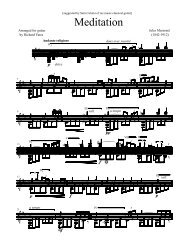
![Finale 2005b - [BWV846-Prelude in C.MUS]](https://img.yumpu.com/43978887/1/190x245/finale-2005b-bwv846-prelude-in-cmus.jpg?quality=85)
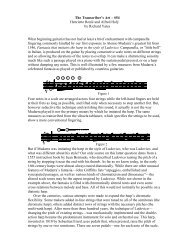
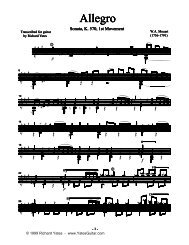

![Finale 2005b - [AirG-TAB.MUS] - Richard Yates Classical Guitar ...](https://img.yumpu.com/37104901/1/190x245/finale-2005b-airg-tabmus-richard-yates-classical-guitar-.jpg?quality=85)

